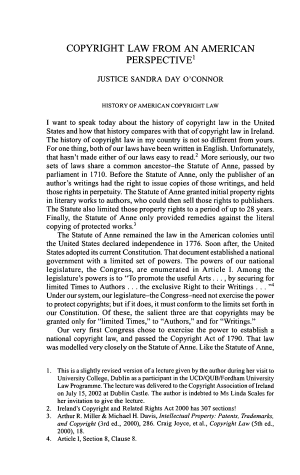By Justice Sandra Day O'Connor
Copyright Law from an American Perspective
July 15, 2002

Transcript
(Excerpt)
HISTORY OF AMERICAN COPYRIGHT LAW
I want to speak today about the history of copyright law in the United States and how that history compares with that of copyright law in Ireland. The history of copyright law in my country is not so different from yours. For one thing, both of our laws have been written in English. Unfortunately, that hasn't made either of our laws easy to read.2 More seriously, our two sets of laws share a common ancestor-the Statute of Anne, passed by parliament in 1710. Before the Statute of Anne, only the publisher of an author's writings had the right to issue copies of those writings, and held those rights in perpetuity. The Statute of Anne granted initial property rights in literary works to authors, who could then sell those rights to publishers. The Statute also limited those property rights to a period of up to 28 years. Finally, the Statute of Anne only provided remedies against the literal copying of protected works.3
The Statute of Anne remained the law in the American colonies until the United States declared independence in 1776. Soon after, the United States adopted its current Constitution. That document established a national government with a limited set of powers. The powers of our national legislature, the Congress, are enumerated in Article I. Among the legislature's powers is to "To promote the useful Arts..., by securing for limited Times to Authors... the exclusive Right to their Writings... " 4 Under our system, our legislature-the
